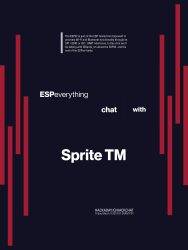When the ESP-8266 first arrived, it was a marvel. For two dollars, you could buy a simple module that could serve as a bridge between WiFi networks and microcontroller projects. It understood the Hayes command set, it didn’t use much power, and, as noted before, it only cost two dollars. The idea of cheap and accessible Internet of Things things was right there for the taking.
 Then hackers figured out what was actually going on inside the ESP-8266. It was a full-blown microcontroller. There was Lua stuff you could put on it. You could program it with the Arduino IDE. It had WiFi. This was the greatest microcontroller release in the last decade, and it came from a company no one had ever heard of.
Then hackers figured out what was actually going on inside the ESP-8266. It was a full-blown microcontroller. There was Lua stuff you could put on it. You could program it with the Arduino IDE. It had WiFi. This was the greatest microcontroller release in the last decade, and it came from a company no one had ever heard of.
Since then, the ESP ecosystem has bloomed, and there’s a new ESP on the block. The ESP-32 is an even more powerful WiFi and Bluetooth-enabled chip that’s just as easy to program, and it costs three dollars. Microcontrollers have never been cooler.
For this week’s Hack Chat, we’re going to be talking all about the ESP. Our guest for this Hack Chat should need no introduction, but if you’re unfamiliar, [Sprite_tm] plays video games on his keyboard and has installed Linux on a hard drive. He also works at Espressif, the company behind the ESP-8266 and ESP-32, where he’s applied his skills towards tiny Game Boys and miniature Macs.
During this week’s Hack Chat, we’re going to be covering everything about the ESP, including peripherals, ultra-low power consumption, SIP packages, and what’s coming up for the ESP family. You are, as always, welcome to submit your questions for [Sprite]; just add those as a comment on the Hack Chat page.
Our Hack Chats are live community events on the Hackaday.io Hack Chat group messaging. [Sprite]’s in China, so we’re not doing this one at the usual time: This week, the Hack Chat will happen at 7:00 am, Pacific, Friday, March 9th. Want to know what time this is happening in your neck of the woods? Have a countdown timer!
Click that speech bubble to the right, and you’ll be taken directly to the Hack Chat group on Hackaday.io.
You don’t have to wait until Friday; join whenever you want and you can see what the community is talking about.

















what no comments yet? Your chance to speak with the all time master and no excitement?
This gon be gud!!!!
is this the esp chat like in precognition or clairvoyance?
Mesh network ready for ESP32?
Same question here
So, he’s going to point us to the source code?
B^)
I’m interested in this subject. Does anyone know how many hours ‘Pacific’ is behind GMT?
I could find out but why not one person put it in the article so thousands don’t have to? Thanks.
about 8
google knows.
I was interested in micropython on the esp32, but I don’t think they have been able to implement bluetooth.
yes they have.
do you have a link for this?
is there an easy way to program the esp32 in assembly?
Idea: s100 monitor board to connect over wifi to your system and maybe also one of those tiny oleds which can be written to from anywhere on the bus. I know it would take much more than one esp32, but it could be really good
the main annoying thing I’ve found with the esp32 so far is that (unlike the esp8266) the digital pins (not supply voltage) are NOT 5v tolerant.. Stuffed if I know why they did that…
On ESP8266 the pins ARE NOT 5V tolerant. Of course it works, at least for some time, but you can easily damage module.
Alright where are the $3 esp32s can’t find on the usual suspects.
Sorry I missed the chat. I would have asked questions re the state of commercial adoption of the ESP chips in IoT products, Also what OSs pr environments have been most popular in such commercial uses. I have a side project for an IoT application and I’ve been playing with a few different devices, but the ESP8266 has been the most gratifying to play with so far. It’s still head-exploding what can be accomplished with this sub-$5 little wonder.